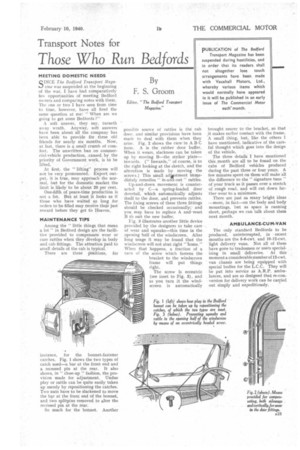Transport Notes for
Page 35

If you've noticed an error in this article please click here to report it so we can fix it.
Those Who Run Bedfords
By F. S. Groom
Editor. "The Bedford Transport Magazine.''
MEETING DOMESTIC NEEDS
SINCE The Bedford Transport Magazine was suspended at the beginning of the war, I have had comparatively few opportunities of meeting Bedford owners and comparing notes with them. The one or two I have seen from time to time, however, have all fired the same question at me: " When are we going to get some Bedfords ?"
A soft answer, they say, turneth away wrath. Anyway, soft answers have been .about all the company has been able to provide for these old friends for nearly six months. Now, at last, there is a small crumb of comfort. The unwritten ban on commercial-vehicle production, .caused by the priority of Government work, is t6 be lifted.
At first, the " lifting" process will not be very pronounced. Export output, it is true, may approach the normal, hut for the domestic market the limit is likely to be about 20. per cent.
One-fifth of peace-time production is not a lot. But at least it looks as if those who have waited so long for orders to be filled may receive their just reward before they get to
MAINTENANCE TIPS Among the " little things that mean a lot" in Bedford design are the facilities provided to compensate wear or cure rattles when they dbvelop in body and cab fittings. The attention paid to small details of the cab is typical.
There are three positions, for
instance, for the bonnet-fastener catches. Fig. 1 shows the two types of catch used—a bar at the front end and a recessed pin at the rear. It also shows, in " close-up " fashion, the provision made for adjustment. Undue play or rattle can be quite easily taken up merely by repositioning the catches. Two nuts have to be slackened to move the bar at the front end of the bonnet, and two splitpins removed to alter the recessed pin at the rear.
So much for the bonnet. Another
possible source of rattles is the cab door, and similar provisions have been made to deal with them when they arise. Fig. 2 shows the cure in A B C form. A is the rubber door buffer. When it wears, slackness can be taken up by moving B—the striker plate— inwards. (" Inwards," of course, is to the right looking at the sketch, and the alteration is made by moving the screws.) This small adjastment immedialely remedies " in-anM-out " rattles.
Up-and-down movement is counteracted by C—a spring-loaded door dovetail, which automatically adjusts itself to the door, and prevents rattles. The fixing screws of these three fittings should be checked occasionally; and you may have to replace A and reset B th suit the new buffer.
Fig. 3 illustrates another little device provided by the designers to take care of wear and squeaks—this time in the opening half of the windscreen. After long usage it may be found that the windscreen will not shut right "home," When that happens, a fraction of a turn of the screw which fastens the bracket to the windscreen frame will put things right.
The screw is eccentric (see inset to Fig. 3), and as you turn it the windscreen is automatically brought nearer to the bracket, so that makes earlier contact with the frame. A small thing, but, like the others I have mentioned, indicative of the careful thought which goes into the design of the vehicle.
The three details I have mentioned this ,month are all to be found on the cabs of Bedford vehicles produced during the past three or four years. A few minutes spent on them will make all the difference to the " signature tune " of your truck as it passes over a stretch of rough road, and will cut down further wear to a minimum.
There are just as many bright ideas —more, in fact—on the body and body mountings, but as space is running short, perhaps we can talk about them next month.
AMBULANCE-CUM-VAN
The only standard Bedfords to be produced, uninterrupted, in recent months are the 5-6-cwt. and 10-12-cwt. light delivery vans. Not all of them have gone to tradesmen or users specializing in small deliveries. At this momenta considerable number of 12-cwt. van chassis are being equipped with special bodies for the L.C.C. They will be put into service as A.R.P. ambulances, and are so designed that re-conversion for delivery work can be carried out simply and expeditiously.




























































